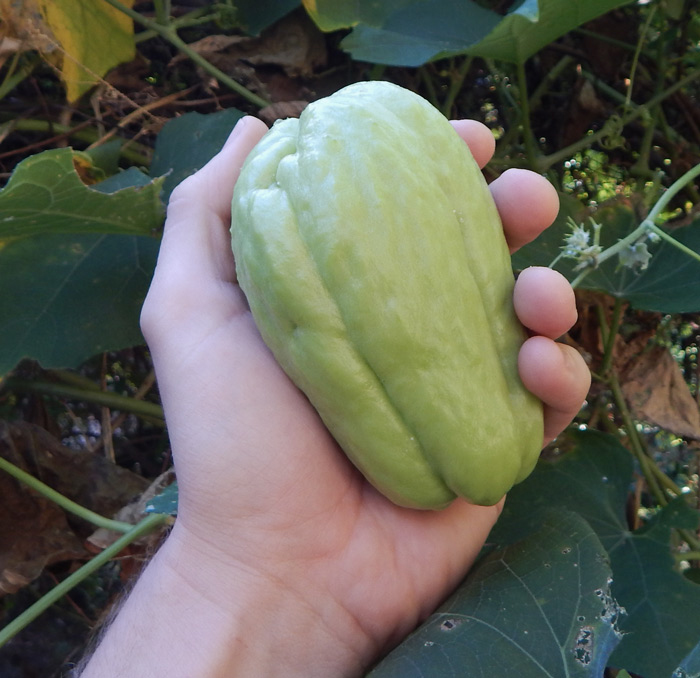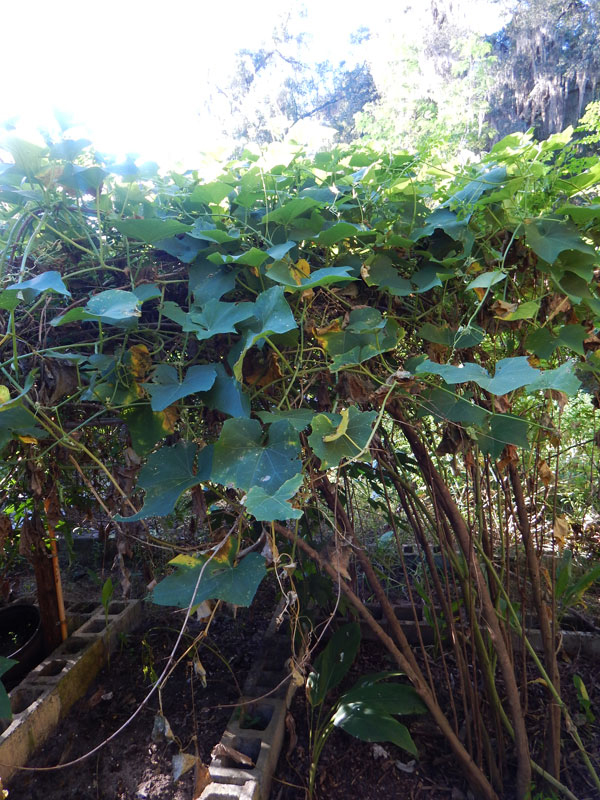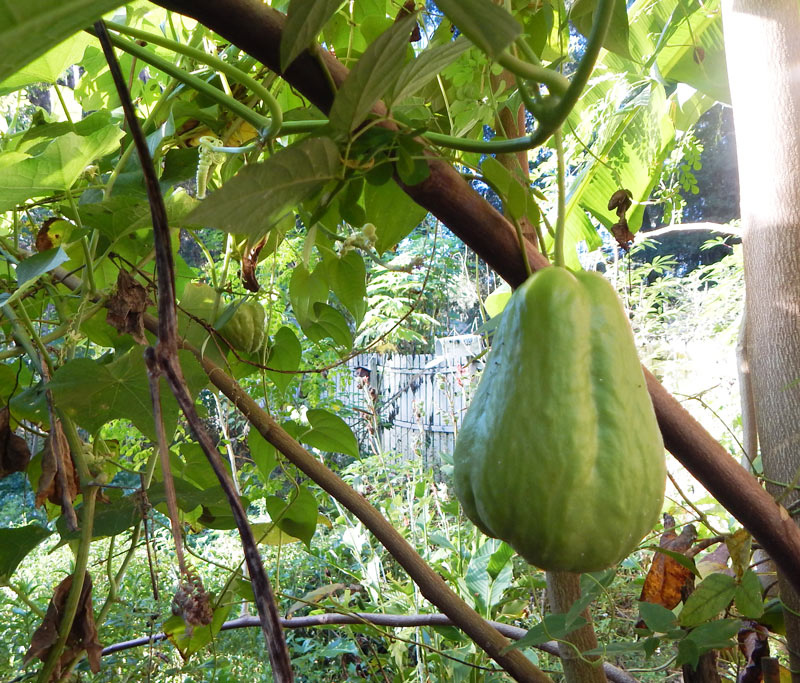Chayote Squash are Delicious!
This is my second year growing chayote squash and I’m thrilled to have them making their way into the kitchen.
I think it’s quite unfortunate that they’re called “squash,” since they taste nothing like a squash. Chayote taste more like a crisp cucumber mixed with a hint of pear and fresh green beans. Juicy and refreshing — more like eating a mild fruit than eating any other squash.
This is understandable, since they’re in the same family as melons and cucumbers. Some have called chayote squash “vegetable pears,” which isn’t a bad nickname. They’d certainly fit much better in a fruit salad than zucchini would.
More from David the Good: 10 Reasons to Garden NOW!
How to Grow Chayote Squash
Growing chayote isn’t hard if you have a long enough warm season (I’ve read 150 days). I originally planted mine in March of last year at the base of a pomegranate tree off the back porch.
They ate the tree.
This is fine, because by the time they climbed over the top of that pomegranate, I already knew it wasn’t going to produce fruit that year. The pmegranate blooms had dropped, so I said, “forget it! Thou art a chayote trellis, non-bearing knave!”
Chayote really are beautiful. Here is a still growing chayote fruit, almost ready for harvest:
What Makes Chayote Squash Unique
Unlike their squash cousins, chayote don’t produce seeds. Instead, the entire fruit surrounds a single embryo in the middle. To grow a new vine, you need to plant the fruit itself. I buried mine half-way in the ground and they did fine.
Here’s what mine look look coming back from the ground, plus I show you how I plant them:
Chayote Make a Great Pass Along Plant
These chayote originally came from my friend Joe Pierce of cob oven fame. Since frost will take a chayote squash vine to the ground, he puts some of the final fruits of fall on the porch and lets them sit until spring when they can be planted out again.
They’ll grow big crazy vines right out of the end of the fruit… very strange.
Read more: How to Make Composting Easy
Using Chayote Squash as a Perennial
Growing chayote squash as a perennial is possible in warmer areas of the country (probably zone 8 and warmer). The vines come back fine for me even after nights in the low 20s. Chayote don’t start setting fruit until the fall, so if you live too far north (say, past Georgia) it may be impossible to get a good yield. (Let us know if you’ve heard differently, or if you have luck — I always love to hear gardening stories.)
Mother Earth News did a good article on chayote a few decades back and the link is here. Lots more info worth checking out. It has the potential to be a remarkably productive plant — I’ve heard of folks around here getting close to a hundred fruits and having the vines climb way up into the oaks.
Though I’ll bet I’m the only one growing them on a pomegranate tree.
David The Good is a Grow Network Change Maker, a gardening expert, and the author of five books you can find on Amazon: Compost Everything: The Good Guide to Extreme Composting, Grow or Die: The Good Guide to Survival Gardening, Totally Crazy Easy Florida Gardening, Create Your Own Florida Food Forest, and Push the Zone: The Good Guide to Growing Tropical Plants Beyond the Tropics. Find fresh gardening inspiration at his website TheSurvivalGardener.com and be sure to follow his popular YouTube channel.











COMMENTS(30)
Sounds great. Where can I get some? Central Washington
Aloha John! Amazon.com in the Grocery and Gourmet foods sections, and probably Whole Foods and local co ops.
These are called merlitons in New Orleans. When I was a kid, just about everyone had them growing in their backyard. We traditionally eat them stuffed with seafood, or in a casserole. I didn’t know they were called chayote squash until I moved out of the state!
Catherine, I’m also from the Big Easy and we always called them Mirlitons. I couldn’t find them when I moved to CO because (1) I didn’t know they only grew in warm climates and (2) I didn’t know they were called anything but Mirlitons! LOL
Where can I get some Chayote to get started with them. I’m in North Florida so maybe they’ll do well here.
Publix sells them here in South Florida in the produce isle near the zucchini.
I lived in Guatemala for several years. Everyone there grew these, I love them. You can eat the leaves too which are wonderful. They take the leaves and roll masa in them and steam a whole bunch of them together in a pot. When they are done they put salsa on them. You have to try them. I just remembered they make a gravy out of pumpkin seeds and pour over it too.
You wrote a great article. How about letting us know where e can buy the seeds. Thank You
Just found out, you need the whole squash. The seeds have to germinate in the squash. You will need to buy a few of them.
I have lots of oak trees. Where can I can get a start from? I live in central Texas.
The HEB grocery store in Abilene Texas sells the chayote squash and I planted mine in early March in a pot in kitchen window and it took a while but started vining. Then planted outside and is doing well.
Anybody know where I can get some? I live in central Texas, thinking that they might just grow here, I would love to try.
I live in central Texas too and you can get them at HEB in the produce section. I start mine in a glass with the water touching the bottom of the chayote and leave them ( small end down) till the leaves start shooting out the top. At that point you can plant the chayote and leave half showing. It will take off from there.
In Australia these are called chokos and I grow them in Canberra which is far enough south that we get frost so the plant dies back over winter. Mine does head up our apple tree and into our kiwi fruit vine. I have only planted it once and it comes back from the roots every year. We only get an autumn harvest, However, further north where the plant doesn’t die back over winter they get two harvests (spring and autumn). It must not like the heat of the summer.
I would never describe it as tasty (although it is certainly mild). Its advantage is that it picks up what ever flavour you want to give it. Add apple pie spices and slice and cook like an apple pie and it is indistinguishable from an apple pie. Yesterday I substituted it for potatoes in a potatoe and leek soup. I use it in a mustard fermented relish and it works great in curries as it takes up the curried spices.
For “Starts”, go to your local supermarket and buy a few. They will sprout from the “fat” end. I’m the produce guy at my local Food Lion and we have a few of these “sprout” after being on the rack for a while. Too bad I live too far North, (Western North Carolina), to grow them.
We call these chokoes in Australia, they come with either a cream colour skin or green. I grow both types and love them as they can be used in both savoury recipes as you would use zucchini or as a dessert if sweetened and served with cream or icecream. They don’t have seeds, you need to get them when they start to sprout from the wide end and plant them. The vines get quite large and produce many friuts which can be used small or kept for up to a month in your veggie crisper in the fridge.
I live in north florida and our local Walmart has them in the produce section for $.88 each. They germinate just fine.
I grew chayote, and ate quite a few leaves and shoots as they go crazy. It set first blooms, but unfortunately it got some sort of wilting disease, which eventually killed the plant. I bought the fruit from the store (even Vons now carries it), and very possibly disease was already in it as the plant kept wilting from the beginning, but vigorous new leaves kept growing for a while. I almost was thinking that is normal -old vines die and new ones come. No other plants I have in the garden had any wilting disease. Not sure, if I should try again, in different place of my garden…Leaves are delicious – young and older ones are still tender.
I live near Houston, and I bought mine in a dollar store. Look for ones with the seed starting to come out of the large end. One can usually find them in Kroger’s, HEB, Randall’s and other large food stores. Mexican markets are also a good source.
Sit it on the counter and it will start to sprout. Plant it at a 45 degree angle, small end down, make sure there is something for them to climb on. I have a couple of vines that are 2.5 stories up a neighbors large tree..
I also made the mistake of putting one in an annual bed and it took that bed and the bed next to it over. Very productive though…
What about central Oklahoma….when do I plant and do they need a trellis/tree/something to grow on?
Excellent article! Sounds like a variety I definitely have to try.
Ok, bought two at the grocery store, excited to try them. Ate one, it had no flavor, very firm like an apple. The seed was very small, pale sliver thing at the bottom. Didn’t see any reason to eat the other one. Can’t see planting it as the first one had no appeal and would not eat it. Since most give them a good report, was this one not mature enough? if so, how do you determine when they are ripe and ready to eat?
Thanks
In Southern Africa it is referred to as a Shoo-shoo. The old folk used to cut it in small squares, boil it with butter added, add a stick of cinimon and some crusts of stale bread this is then sweetened with a bit of sugar. Never the less i did not ever acquire the taste. Good to know the leaves can be used.
I’m excited! I’m growing one in a pot because we live in a townhouse. I might have to transfer to the biggest one I can find soon.
Awesome! So happy to hear you aren’t letting space be a deciding factor. Keep up the great work!
where can i find one to grow them as i dont believe I can find them in seeds
Chaote (also called Choko’s) make up the bulk of “apple” in commercial Apple Pies. They are extremely effective when used as a “filler” in asian meals or stews, as they are sufficiently bland to take on the flavour of whatever they are mixed with.
I have a huge Chayote squash and it is beautiful.It has 2 squash on the whole plant.this is the first year.Can you tell me when do they usually get fruit.?